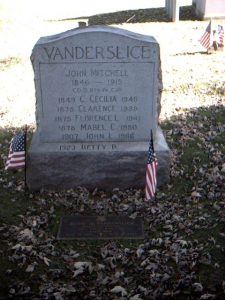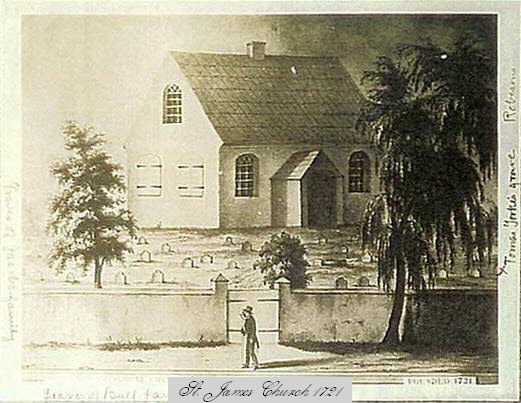
A Brief Parish History
The Colonial Church
1721 Church
Church Building
Glebe House
SPG Schoolhouse
St. James' Cemetery
For additional information or for geneaological research, please link to:
(1.)St. James' Community History Center
(2.) Genealogy. To schedule a visit:
email: history@stjames-episcopal.org
or contact the parish office at 610-489-7564.
St. James' has a rich heritage, dating from its first worship service conducted in 1700 by the Reverend Evan Evans, pastor of Christ Church, Philadelphia. Since then the parish has seen many changes in the surrounding countryside and grown along with the area as it progressed from a rural to a suburban economy. Throughout its more than three hundred year history, St. James' has been committed to faithful worship, Christian education, outreach and service.
Many of St. James' historical records are available for review by appointment through the Church office. Our list of interesting Historical Facts about the parish offers a brief overview of the more extensive information.
The Colonial Church
Edward Lane, the actual founder of St. James', acquired his extensive lands along the Perkiomen and Skippack creeks before 1700, after emigrating from Bristol, in the west of England. Other Church of England families from Bristol, and nearby Wales, came to settle on his land in the late 1600's and early 1700's. They built a log church on land, presumably donated by Mr. Lane, soon after 1700. This first St. James' Church burned a few years later in a fire that destroyed all of the church records of the day.
The "Old Stone Church" of 1721
To replace the original log structure, a new stone church was erected in 1721, under the direction of the Reverend Robert Weyman, of St. David's Radnor, who was also in charge of the St. James' parish, at the time. This stone church building stood across the road from the present church in the center of the current cemetery, which was then the churchyard.
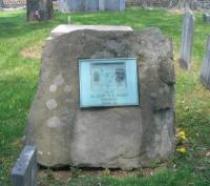

Several artifacts from the 1721 church, including its cornerstone which can be seen in the front wall of the present church, remain today. A Vestry book, used to record minutes of Vestry meetings from 1737 to 1859, is preserved in Philadelphia by the Historical Society of Pennsylvania. The communion table in use today is the table crafted by a colonial cabinet-maker for the same use in the stone building. This table was restored in 1912 at the behest of ex-governor Samuel Pennypacker, a member of the congregation at the time, after being discovered under a coat of blue paint in the church kitchen. Other items include a wooden cross and candlesticks made from the window shutters of the 1721 building, as well as a Sheffield ware communion service.
Unfortunately, for our time, the 1721 building was demolished to allow for cemetery expansion and to provide stone for use in the walls of St. James' current building.
The Church Building
The construction of St. James current church was begun under the direction of the Reverend George Mintzer, who began his rectorship in 1842. Ground was broken in 1843 and the completed building was dedicated in 1845. A tablet in memory of Mr. Mintzer can be found on the wall behind the present pulpit.

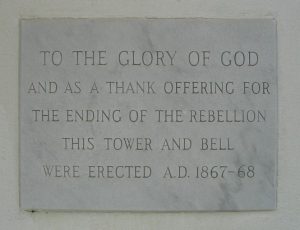
Several members of the parish lost in that conflict are buried in St. James' cemetery. Among these is the grave of John M. Vanderslice, recipient of the Congressional Medal of Honor, for service during the Civil War.
The parish house was added to the original building in 1905. In the 1950's, under the direction of Reverend Edward Platts, the parish house was completely rebuilt and expanded to accommodate a growing congregation. Platts Hall was officially dedicated in 1958.
The Glebe House
In a will dated 1732 William Lane, son of the founder of the parish, left 42 acres of land for the "use of ministers who shall serve at St. James'." This land known as a "glebe" was laid out as a community which is now the village of Evansburg. The original rectory, the "Glebe House," was built prior to 1737. Today the building is no longer used as a rectory...today it houses the St. James Outreach House. Legend has it that George Washington held a counsel of war in the study of the Glebe House during the Revolutionary War.
The SPG Schoolhouse
The little building tucked in the western corner of St.James' Cemetery is the schoolhouse of the Society for the Propagation of the Gospel (SPG). This missionary organization founded by the Church of England during colonial times sent men to preach and to teach the children of the colonies. A typescript of a petition, addressed to the Honorable Society for Propagating the Gospel requesting appointment of a minister, is signed by members of the congregation and dated 1736. Construction is thought to have occurred circa 1788.
The building has undergone several incarnations. It has been used as a public schoolhouse, a print shop, (following renovations and addition of two rooms in 1924) as a mortuary chapel, a public library and presently as the home of the St. James' Community History Center.

ST. James' Church Cemetery
On the north side of Germantown Pike surrounded by a low stonewall and across from the present church sits the St. James' Cemetery. The cemetery has been in continuous use since the 1700s. The oldest legible stone in the cemetery is that of Susanna Leubacher who died in 1723 and whose epitaph is written in German, English and Hebrew. Over 150 Continental soldiers, who died following the Battle of Germantown, are buried here. Many of these soldiers are interred in a mass burial mound for those whose names will remain forever unknown. Here also is the grave of Captain Vachel D. Howard, a soldier in the Maryland Light Dragon, who died in March, 1778 at the age of 32. George Washington is said to have visited the churchyard at a later date and remarked on his acquaintance with this soldier.



Here too are the Victorian style graves of several prominent St. James' families who provided funds still used today to assist with upkeep of the cemetery. The size of the cemetery has increased several times over the years growing first toward the west and then the east expanding out from the site of the original churchyard. In the 1920s the stonewall was rebuilt and extended to include the SPG schoolhouse.
Scenes of St. James' Cemetery
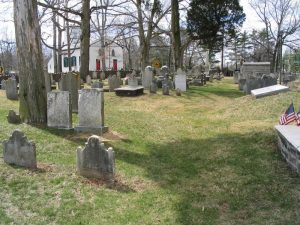
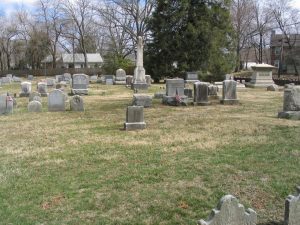

John M. Vanderslice, Congressional Medal of Honor recipient Civil War
